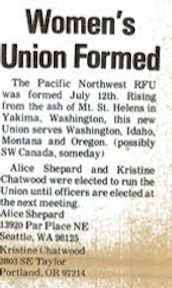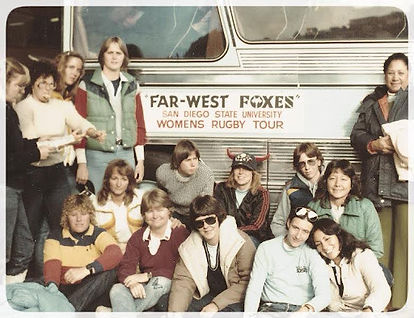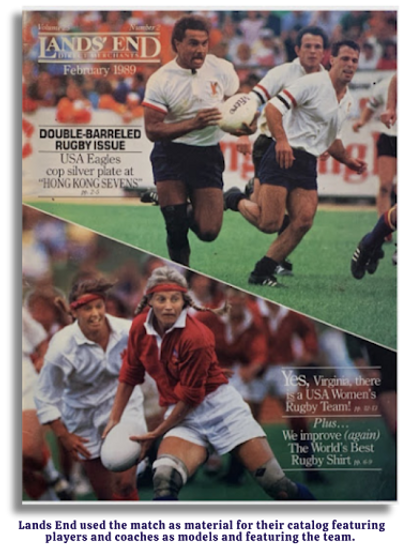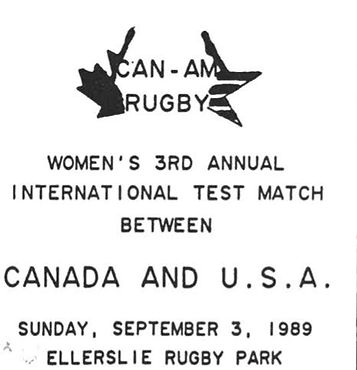1975 Sexist OSU Newsletter
The Old Man, the newsletter of the Ohio State University Men’s Rugby club announced the formation of the Ohio State women’s team. Note the graphic illustration of a female player.
1977 The Pitch
The Tube and the Pitch, two different Ohio State Women’s team newsletters from 1977 show the grassroots organizing, bawdy nature of women’s rugby at the time.
Support us today!
When you contribute to the U.S. Women’s Rugby Foundation you become part of a movement to support girls and women involved in rugby.
We are a 501(c) (3) non-profit organization.
All donations made are tax deductible.

Support us today!
When you contribute to the U.S. Women’s Rugby Foundation you become part of a movement to support girls and women involved in rugby.
We are a 501(c) (3) non-profit organization.
All donations made are tax deductible.




The 1980s were notable for the tremendous growth in women’s rugby as well as the formation of the women’s national team and the first women’s international match.


In early 1980, the fledgling Women’s Committee was folded into USAR and became the USARFU Women’s Committee. The inclusion of women’s rugby within established governing structures (local unions, USAR) was

(Early Rugby Advertisement)
a contentious issue throughout the 1980s. Unions were governed almost exclusively by men who often refused to admit women’s teams or admitted women’s teams, charged them dues and provided no services or representation. While many women advocated for creating unions and governing structures exclusively for women, others advocated for infiltrating the governing structures of unions and ‘making change from within’. This turned out to be a wise course and in addition to creating stronger unions it proved to be a training ground for women administrators. It’s important to convey how young the women administrators were at the time. Most were just out of college, beginning careers and playing rugby - often starting clubs to continue their playing careers. They communicated through snail mail and phone, and met regularly at regional and national events.
In the short run, affiliating with established territorial unions provided women with opportunities to participate in regional select side play as well as InterTerritorial Tournaments (ITTs). Local and regional select side play was very competitive and offered players an opportunity to work under top coaches and with top players. The ITTs eventually became the sole vehicle for selecting the U.S. Women’s National Team.
Some unions were progressive, in 1980 Karen Dunfey became the first woman president of the New England Rugby Football Union (NERFU), Dana Bateman was secretary of the EPRU and Director of the ERU, Leslie Kellenberger was secretary of the North Carolina Unions and ‘At-large’ ERU Director.


Laurel Lockett became the first woman referee to achieve a B2 rating and referee men's league play.

Big Apple Classic
September 20 & 21, 1980 New York, NY


1983: First Eastern Rugby Union Championship




By 1980, there were 212 women’s teams in the U.S. All teams were classified as club teams (there was no distinction for college and no youth or high school teams existed). Most clubs relied heavily on weekly tournaments for games.
Florida State University won the 1980 Women’s National Rugby Classic, the de facto National Championship. The Classic included eight teams from the East, Midwest and West (while invited, no Pacific teams attended). Throughout the 1980s the National Championships were dominated by Florida State and Beantown who met four times in the finals and combined, won seven titles in nine years.
1981: The Women’s Rugby Classic is renamed the Women’s National Championship. The First Annual Women’s Rugby National Championship was held May 23 – 25 in Oakbrook IL. The field included sixteen teams. Teams played four matches over two days. Belmont Shore beat Beantown in a close final. Players from both teams were awarded gift boxes of make-up from Avon along with champagne - not a good combo after a tough rugby weekend.


MVP Kathy Cantu
Belmont Shores

1980 the California Kiwis become
the first U.S. women’s team to tour New Zealand


1980 the Pacific Northwest forms the fourth Women’s Union (Left).
Marcia Borge (right) one of the early women’s committee members and architect of the women’s national club championships was at the forefront of a gifted group of female leaders.

1982 Beantown claim their first National Championship

1980 San Diego Surfers

1981 Houston Heathen Hearts

1982 Dartmouth College Women

1981 San Diego State University

1985 Norwich University

1983 Jennie Redner, one of the first women referees to officiate men's matches in action.

1985 New Orleans Halfmoons

1989 Santa Monica Women

2nd Annual Maid in the Shade Women's Rugby Tournament (Florida State University) March 18-19, 1989

By 1989, there were three high school teams in the U.S. - St Agnes High School, Lake Braddock High School and West Springfield High School. All were in Northern Virginia.

1980 Midwest women form the first Women’s Referee Society

One of the great stories in the history of U.S. women’s rugby is the 1984 National Championships.The Chicago Women’s Rugby Club set a high bar for the National Championships, hosting them at The Polo Grounds. The 1984 Championships were the first to host an awards banquet and to select an All-Tournament Team – which became an early identifier for the 1987 Women’s National Team. But how they were able to pull off the Championship is really a story worth hearing. Million Dollar Babies: 1984 National Championships.
Referees were warned not to referee at the 1984 Women’s National Championships. Steve Cohen risked his referee career, crossing lines to referee at the 1984 Championships. In gratitude the Women’s Committee awarded Steve a million dollar check.

"The Chicago Lions RFC had quite a bit of influence in Midwest rugby at that time and convinced the Midwest Referees’ Society not to support the Women’s Nationals that year. Thankfully we were rescued by the East and West Referees’ Societies. In fact a number of referees really stepped up to help us." (Mary Larkin, Chicago WRFC)
For much of the 1970s and 1980s rugby (men's and women’s was ‘counter culture’. Much of this had to do with the drinking culture associated with rugby - it was not uncommon to have kegs on the field (college and club), beer companies were the sponsors for a number of events, stories of drunken escapades were proud lore. Team socials abounded with raunchy songs and dances. There were few if any governing bodies that policed the behavior of players. Women partied as hard as the men (but with less of the sexual violence). One offshoot of the counter culture was the ways in which women’s teams poked fun at the patriarchy that blanketed women’s rugby. The Eugene Housewives were an example of women changing the raunchy narrative of men’s rugby to a women’s raunchy narrative.

While men wore shirts with, it takes leather balls to play rugby, the Pittsburgh Women’s Team countered with t-shirts that read No Balls at All and the Ohio State Women wore the infamous Iron Ovaries Tee’s.



1983 feature in rugby Magazine on women administrators
National Club Champions 15s
1980: Florida State University v Atlanta Hoydens
1981: Belmont Shore v Beantown RFC
1982: Beantown RFC v Chicago
1983: Beantown v FSU
1984: FSU v Beantown
1985: FSU v San Diego Surfers
1986: Beantown v FSU
1987: Beantown v FSU
1988: Minnesota v FSU
1989: Bay Area SheHawks v FSU




1980 All Star National Champion All Star Team
1980 FSU vs Atlanta Hoyden
Hayden players (black band) scramble for the ball vs Florida State. Florida State won 14-0 (Photo Hagerty)



Georgia Women's Rugby Presents: the 10th Annual Classic City Ruggerfest - November 22 & 22, 1986
The Chicago Women's Rookie Primer - 1985

Colorado Peakers Women's Rugby Club Welcomes You to the 2nd Annual 7's Tournament

Western Territorials CSU Invitational





1985: Women's Invitational Vagabonds, Emissaries and Rugby Nomads (WIVERN)
The opportunity to play for local, regional and territorial championships, a national club championship and to make the ‘All-Tournament team’ was hugely motivating to many women. Not surprisingly, women’s rugby improved, and the blueprint for a women’s national team began to take shape. In 1985, Patrick Foley, a coach from the Midwest, invited top players to take part in an invitational touring side, the WIVERNS. The response to his invitation was overwhelming and in the fall of 1985, thirty top players left to play select side and club teams from England and France. The U.S. dominated their opponents, and the British press took notice.





After the success of the WIVERN tour, the Women’s Committee began to organize a true Women’s National Team. USAR administrators accepted an invitation from the Canada women for the first women’s international match yet declined to recognize a U.S. women’s national team. The Women’s Committee was undeterred, Kathi Morrison, Mary Larkin, Judy Tixier, Diane Terwilliger, Marcia Borge and Kitty Keller generated a list of players from Territorial Championships and the National Club Championship and held the first selection camp at Stanford University. Approximately forty-five
players were invited to a three-day camp that included physical testing and rotating matches. Twenty-one players were selected - they were the first twenty-one Eagles.
The selection camp leading up to the match WAS BRUTAL! The beep test, the mile run, the max lifts and the marathon play for selectors…all in one day with little to no breaks. (Candi Orsini, Eagle #11)

In a petty move, USAR administrators forbade the women from calling themselves the Eagles or using any recognizable USAR logos. They were given no resources for the historic match and no USAR administrators attended the women’s match. Rugby Imports, a supplier historically supportive of women's rugby, stepped up to provide kit for the first women’s national team.

It’s interesting to note that letters to female players frequently reminded them to ‘behave’. This wasn’t without merit, all rugby at the time was very connected to drinking and bawdy behavior. The Women’s Committee was concerned that the fledgling Women’s National Team must not only win, but prove to local, regional and national leadership that women were committed, responsible ambassadors of the game. As women’s Committee Chair Jami Jordan recalls,
there was opposition to the women’s match from USAR. I remember reading a letter from Mary Larkin, the National Events Coordinator, to the women’s team making it clear that the stakes were high and the team was expected to present themselves in a professional manner.
The 1987 U.S. v Canada women’s match was held in Victoria Canada as the curtain opener to the U.S. Men v Canada. The U.S. women coached by Kevin O’Brien (East) and Dave Hooper (West) were well matched against Canada and both teams played exciting rugby. The U.S. women won the match 22-3.
The U.S. men lost to Canada 20-12. After the match, the Canadians hosted all four teams for a cocktail hour and banquet. The U.S. men’s captain, Fred Paoli and members of the men’s national team took exception to the inclusion of women at the banquet. During the captain's remarks, Paoli took his allotted time to denounce women’s rugby. As Women’s Committee member Mary Larkin offered, ‘at that time men frequently let women know what they approved and disapproved of.’ His remarks offended the women's teams as well as the Canadian hosts.
The U.S. and Canadian women walked out of the banquet. It was a remarkable moment in women's rugby history as it triggered a conversation about the entitlement of the men's national team. While USAR remained ambivalent about the insult, many local unions were unhappy with the insult to their female members and USAR’s lack of support for women’s rugby. This type of blatant sexism was not uncommon at the time, yet this incident seemed to encapsulate the tremendous gap between men’s and women’s rugby - as well as the gap between USAR and local unions. Letters went back and forth in Rugby Magazine. Fred Paoli refused to acknowledge that he did anything wrong but eventually apologized to the Canadians for putting them in a difficult position with their national governing body. Regardless of the men's disapproval the Can-Am series flourished, for the ensuing ten years the U.S. Women went undefeated in this test series.

1988 The First Women’s International match in the U.S., USAR continued to provide minimal support to the Women’s National Team. The WNT was still denied the title of Eagles and from wearing USAR logos. Selection camps and matches were all ‘pay-to-play’ affairs for the women. But public support was growing for the program. (Above: the first USWNT logo)
Rugby Magazines write up on the historic 1987 match including the selections - a list of the first fifteen Women’s National Team players. The team would not be recognized as Eagles or receive caps for a number of years.
As Jami Jordan noted, at the time, Rugby Canada was very supportive of their women’s program. In the 1988-89 files was a request to the USAR Executive Committee to demonstrate their support of the women’s program by attending games. I pointed out that members of the Canadian Executive Committee were attending games. USAR Executive Committee Members were unmoved and would not attend a women’s national team game for the next eight years.

US Women Top Canada, 26-10






The second international and first international women’s match in the U.S. was held on August 2, 1988 at the Can-Am Tournament, Saranac Lake, NY. Kevin O’Brien (East) was the Head Coach and Dave Hooper (West) the Assistant Coach. Both the U.S. and Canada arrived with strong, experienced, talented teams. The U.S backline featured two future Hall of Fame players at the centers (Jenn Crawford and Candi Orsini). The U.S. forwards were successful in delivering the ball the backs needed to score and the U.S. won 26-10.

One of the highlights of the 1988 match was the sponsorship of Lands End who provided jerseys to the U.S. women’s team. Lands End sent a crew to the tournament to cover the match and create a spread for the catalog.



The third U.S./ Canada International was played in Edmonton, Canada, September 3, 1989. The U.S. beat Canada 28-3.


1989: There are three hundred and eleven women’s teams in the U.S.


One of the very interesting pioneers of the 1980s was Laura Combes. Laura was a scrumhalf for the University of South Florida and occasionally picked up with Florida State for tournaments, including the 1979 National Championships. Laura was one of the first women body builders. She was noted for her remarkable physique - a muscularity that was deemed too masculine for women’s body building at the time. Laura also refused to wear high heels on stage and was the first woman to pose with a ‘closed fist’ - something forbidden at the time in women’s competitions. She won the first NPC Nationals in 1980, and won the AAU Ms. America title in 1981. She competed in three professional body building shows, retiring after a sixth-place finish at the 1982 Ms Olympia. She authored Winning Women's Bodybuilding in 1983. Laura, who passed away in 1989, was inducted into the International Federation of Body Builders Hall of Fame in 2002.

















